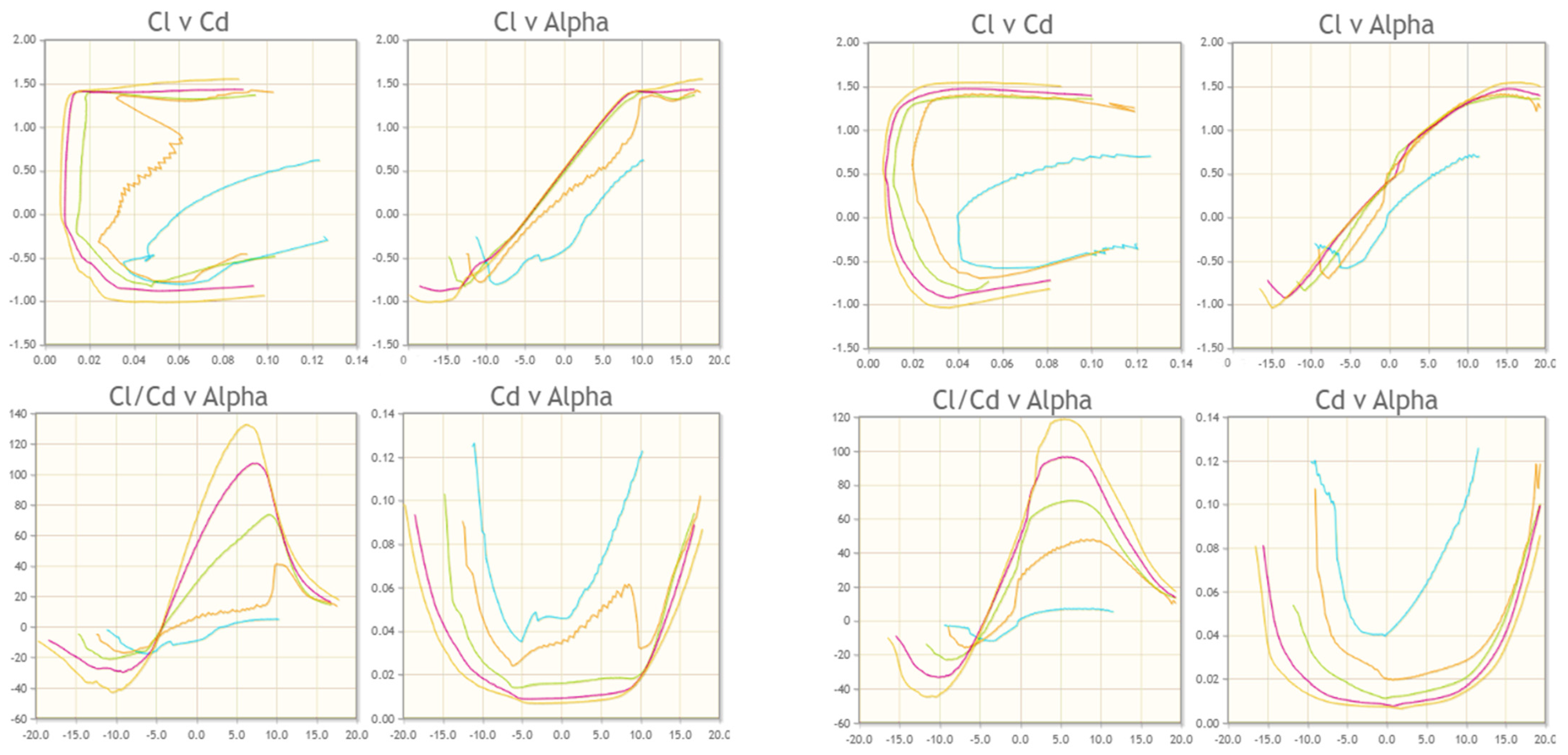Development of an Unmanned Glider for Temperature and Image Monitoring
Abstract
1. Introduction
2. Airfoil Design and Aerodynamic Analysis
2.1. Airfoil Selection and XFLR5 Performance Analysis
2.2. CFD Modeling in ANSYS Fluent
2.3. Wind Tunnel Testing and Validation
2.4. Propeller Flow Simulation and Effects (LBM)
3. Glider Structural Design and Flow Visualization
3.1. Glider Design Calculations
- Wing area (S): 534,710 mm2 (828.80 in2)
- Wingspan (b): 2000 mm
- Chord length (C1, C1’’, C2): 149.97 mm, 149.97 mm, 86.98 mm
- Taper ratio (λ): 0.5799 ≈ 0.6
- Wing cube loading (WCL): 4.087 ≈ 4 (within ideal RC glider range of 3–5)
- Total weight: 46 oz (1.3 kg)
- Thrust (T): 33 oz
- Thrust-to-weight ratio (T/W): 0.80
- Wing surface area (S): 5.75 sq. ft.
- Aspect ratio (AR): 4.6
- Wingspan (b): 6.5 ft (2000 mm)
- Chord length (c): 0.63 ft
- Tail span (bt): 3 ft
- Tail aspect ratio (ARt): 4.6
- Tail area (St): 1.95 sq. ft.
- Tail chord length (ct): 0.63 ft
- Aerodynamic center (Xac): 0.21 ft (behind c.g)
- Center of gravity (Xcg): 0.19 ft (behind wing L.E)
- Stability margin (Sm): −0.04 ft (marginally stable condition)
3.2. Glider CAD Modeling
3.3. CFD Simulation and Flow Visualization
4. Virtual Flight Simulation and Optimization
4.1. AC3D Model Conversion for Flight Simulation
4.2. Simulink Integration and Real-Time Interface
4.3. Visualization and Flight Testing in FlightGear
5. Fabrication and Systems Integration
5.1. Material Selection and Structural Assembly
5.2. Powertrain Integration and Embedded Control
- Wattage = Weight × Power Performance Level
- Current = Wattage/Voltage ≈ 13.1 A
- RPM = 0.4896 × (Wingspan2) − 162.66 × Wingspan + 20,786
- Propeller Diameter = –0.002 × RPM + 35.607
- Pitch = Diameter/1.57
5.3. Sensor Setup and Thermal Protection
6. Discussion
7. Conclusions
Author Contributions
Funding
Data Availability Statement
Conflicts of Interest
References
- Stöcker, C.; Bennet, R.M.; Nex, F.; Gerke, M.; Zevenbergen, J.A. Review of the Current State of UAV Regulations. Remote Sens. 2017, 9, 459. [Google Scholar] [CrossRef]
- Lucia, L.D.; Vegni, A.M. UAV Main applications: From military to agricultural fields. In Internet of Unmanned Things (IoUT) and Mission-Based Networking. Internet of Things; Kerrache, C.A., Calafate, C., Lakas, A., Lahby, M., Eds.; Springer: Cham, Switzerland, 2023. [Google Scholar]
- Shakhatreh, H. Unmanned Aerial Vehicles (UAVs): A Survey on Civil Applications and Key Research Challenges. IEEE Access 2019, 7, 48572–48634. [Google Scholar] [CrossRef]
- Del Cerro, J.; Cruz Ulloa, C.; Barrientos, A.; de León Rivas, J. Unmanned Aerial Vehicles in Agriculture: A Survey. Agronomy 2021, 11, 203. [Google Scholar] [CrossRef]
- Kim, J.; Kim, S.; Ju, C.; Son, H.I. Unmanned Aerial Vehicles in Agriculture: A Review of Perspective of Platform. Control, and Applications. IEEE Access 2019, 7, 105100–105115. [Google Scholar] [CrossRef]
- Brown, C.; Miller, D. The future of UAVs in sustainable aviation. Aerosp. Technol. Rev. 2019, 12, 98–105. [Google Scholar]
- Li, Y. An Autonomous Glider for Marine Surveillance. Int. J. Intell. Robot. Appl. 2018, 2, 427–439. [Google Scholar]
- Zhang, Y.; Zhou, Y.; Chen, W.; Zhang, W.; Gao, F. Design, modeling and numerical analysis of a WEC-Glider (WEG). Renew. Energy 2022, 188, 911–921. [Google Scholar] [CrossRef]
- Finn, R.; Wright, D. Unmanned aircraft systems: Surveillance, ethics, and privacy in civil applications. Comput. Law Secur. Rev. 2022, 28, 184–194. [Google Scholar] [CrossRef]
- Goetzendorf-Grabowski, T.; Rodzewicz, M. Design of UAV for photogrammetric mission in Antarctic Area. Proc. Inst. Mech. Eng. Part G J. Aerosp. Eng. 2016, 231, 1660–1675. [Google Scholar] [CrossRef]
- Rango, A.; Laliberte, A. Impact of flight regulations on effective use of unmanned aircraft systems for natural resources applications. J. Appl. Remote Sens. 2010, 4, 043539. [Google Scholar]
- Alkaabi, K.; Abuelgasim, A. Applications of Unmanned Aerial Vehicle (UAV) Technology for Research and Education in UAE. Int. J. Soc. Sci. Arts Humanit. 2017, 5, 2321–2326. [Google Scholar]
- Rathinakumar, G.; Ntantis, E.L. Designing a quadcopter for fire and temperature detection with an infrared camera and PIR sensor. Drones Auton. Veh. 2024, 1, 10003. [Google Scholar] [CrossRef]
- Arora, S.; Ntantis, E.L. Customization and Payload Integration of Hexacopter for Enhanced Grocery Delivery. Multidiscip. Sci. J. 2024, 6, 2024126. [Google Scholar] [CrossRef]
- Zawawi, H. A review: Fundamentals of computational fluid dynamics (CFD). AIP Conf. Proc. 2018, 2030, 020252. [Google Scholar]
- Rao, R.K.S. Modelling and simulation of aerofoil element. Int. Res. J. Eng. Technol. 2018, 5, 2056–2059. [Google Scholar]
- Joseph Daniel, S. Daniel Performance Analysis of Asymmetrical Airfoil for Subsonic Flight. Int. J. Progress. Res. Sci. Eng. 2020, 1, 8–11. [Google Scholar]
- Demir, H.; Ozden, M.; Genc, M.S.; Cagdas, M. Numerical investigation of flow on NACA4412 aerofoil with different aspect ratios. EPJ Web Conf. 2016, 114, 02016. [Google Scholar] [CrossRef]
- Yousefi, K.; Saleh, R. The effects of trailing edge blowing on aerodynamic characteristics of the NACA 0012 airfoil and optimization of the blowing slot geometry. J. Theor. Appl. Mech. 2014, 52, 165–179. [Google Scholar]
- Ntantis, E.L.; Xezonakis, V. Aerodynamic design optimization of a NACA 0012 airfoil: An introductory adjoint discrete tool for educational purposes. Int. J. Mech. Eng. Educ. 2024, 53, 611–630. [Google Scholar] [CrossRef]
- Chaturvedi, D.K. Modeling and Simulation of Systems Using MATLAB and Simulink; CRC Press: Boca Raton, FL, USA, 2010. [Google Scholar]
- Horri, N.; Pietrasko, M. A tutorial and review on flight control co-simulation using Matlab/Simulink and Flight Simulators. Automation 2022, 3, 486–510. [Google Scholar] [CrossRef]
- Ho, C.M.; Carr, L.W. The aerodynamic characteristics of NACA 4-digit and 6-series airfoils in subsonic flow. J. Aircr. 1971, 8, 987–992. [Google Scholar]
- Wang, L.; Li, Y.; Liao, Y.; Pan, K.; Zhang, W. Adaptive heading control of unmanned wave glider with heading information fusion. Control Eng. Pract. 2019, 85, 216–224. [Google Scholar]
- Chai, J.; Conlon, B. Conceptual Design of a Martian Reconnaissance Glider; American Geographic Union: Washington, DC, USA, 2020. [Google Scholar]
- Spinner, S. An Overview of High Fidelity CFD Engine Modeling. AIAA SciTech 2022, 45, 2022. [Google Scholar]
- Ntantis, E.L.; Francis, E.; Fazel, H.; George, J.; Blal, M.; Emthias, M.; Pugazendi, V. Numerical study on a supersonic flow around a bullet. WSEAS Trans. Fluid Mech. 2023, 18, 1–9. [Google Scholar] [CrossRef]
- Ntantis, E.L.; Francis, E.; Pugazendi, V.; George, J.; Tarek, A.; Emthias, M.; Rasheed, S. Study of sinusoidal perturbations on the leading edge of an aircraft wing. J. Aeronaut. Astronaut. Aviat. 2021, 53, 375–386. [Google Scholar]
- Lehmann, M. Esoteric Pull and Esoteric Push: Two Simple In-Place Streaming Schemes for the Lattice Boltzmann Method on GPUs. Computation 2022, 10, 92. [Google Scholar] [CrossRef]
- Hosseini, S.; Vaziry-Zanjany, M.A.; Ovesy, H.R. A Framework for Aircraft Conceptual Design and Multidisciplinary Optimization. Aerospace 2024, 11, 273. [Google Scholar] [CrossRef]
- Pornet, C.; Isikveren, A.T. Conceptual design of hybrid-electric transport aircraft. Prog. Aerosp. Sci. 2015, 79, 114–135. [Google Scholar] [CrossRef]
- Garmann, D.; Miguel, R.V.; Orkwis, P.D. Three-dimensional flow structure and aerodynamic loading on a revolving wing. Phys. Fluids 2013, 25, 034101. [Google Scholar] [CrossRef]
- Epstein, B. Comparative study of three-dimensional wing drag minimization by different optimization techniques. J. Aircr. 2012, 46, 526–541. [Google Scholar] [CrossRef][Green Version]
- Zhao, A. Analysis on the Aerodynamic Characteristics of a Continuous Whole Variable Camber Airfoil. J. Phys. Conf. Ser. 2019, 1215, 012005. [Google Scholar] [CrossRef]
- Perry, A.R. The FlightGear Flight Simulator History, Status and Future; Citeseer: Princeton, NJ, USA, 2021. [Google Scholar]
- Barrio, L.D.; Korek, W.; Millidere, M.; Whidborne, J. Analysis of Visualisation Systems in Flight Simulators. In Proceedings of the AIAA AVIATION 2023 Forum, San Diego, CA, USA, 12–16 June 2023; pp. 2023–3476. [Google Scholar]
- Leon, A.E.; Pineda, R.; Yanez, A.; Caggiano, A. Development of a Low-Cost Glider UAV for Environmental Monitoring. Materials 2020, 13, 2310. [Google Scholar]
- Dalamagkidis, K. Classification of UAVs. In Handbook of Unmanned Aerial Vehicles; Valavanis, K., Vachtsevanos, G., Eds.; Springer: Dordrecht, The Netherlands, 2015. [Google Scholar]
- Adams, S.; Friedland, C.A. A Survey of Unmanned Aerial Vehicle (UAV) Usage for Imagery Collection in Disaster Research and Management. In Proceedings of the 9th International Workshop on Remote Sensing for Disaster Response, Stanford, CA, USA, 15–16 September 2011; pp. 15–16. [Google Scholar]


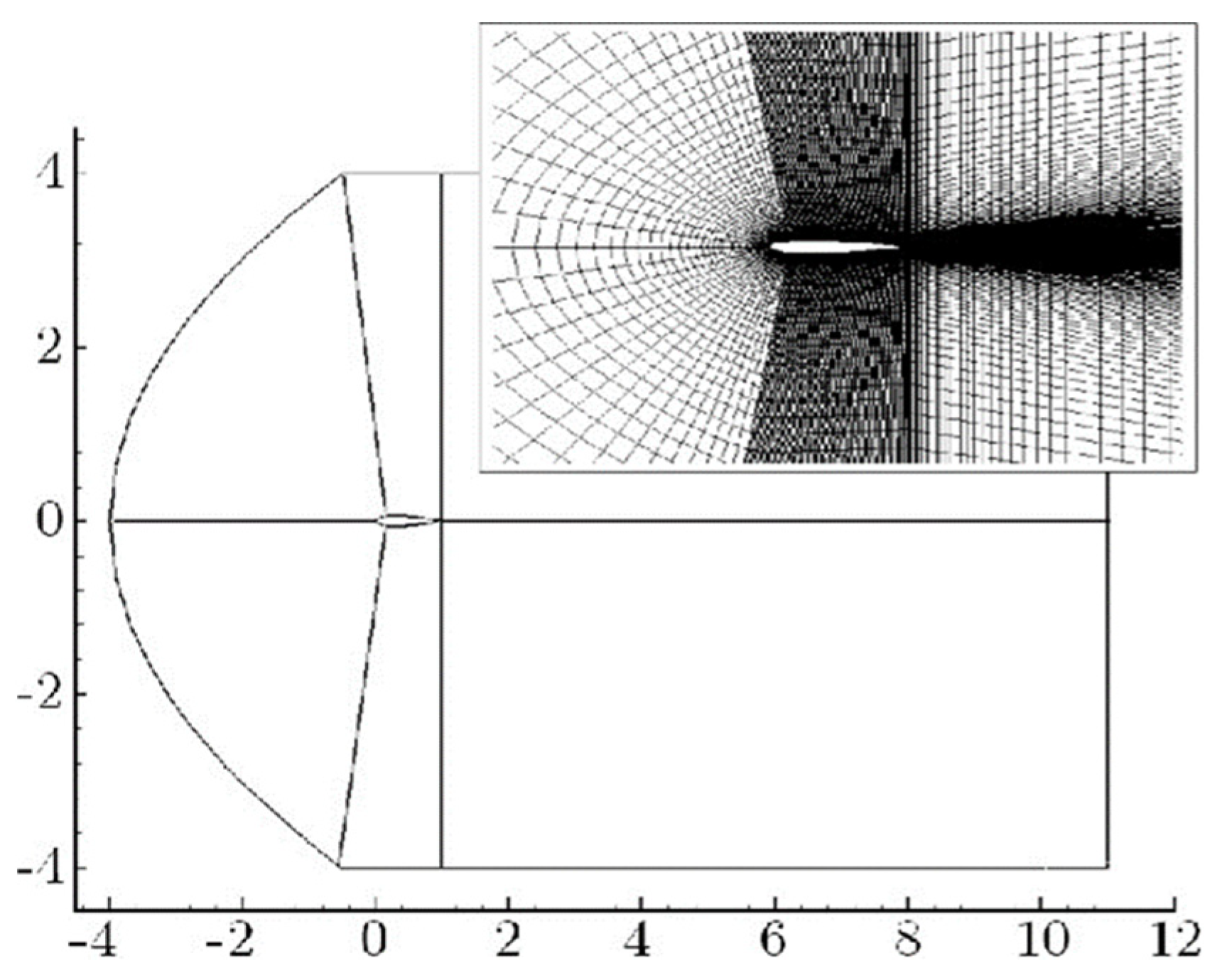
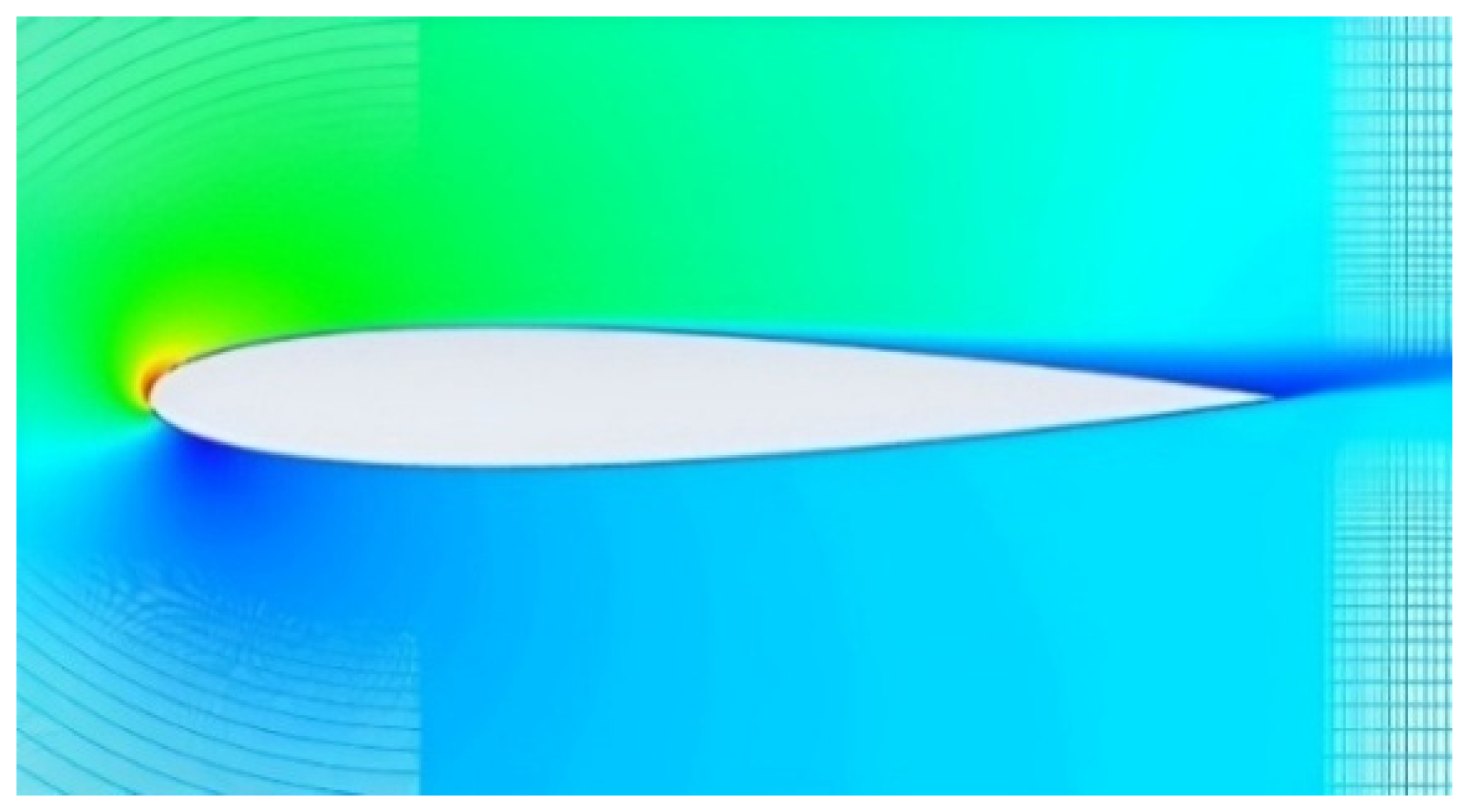

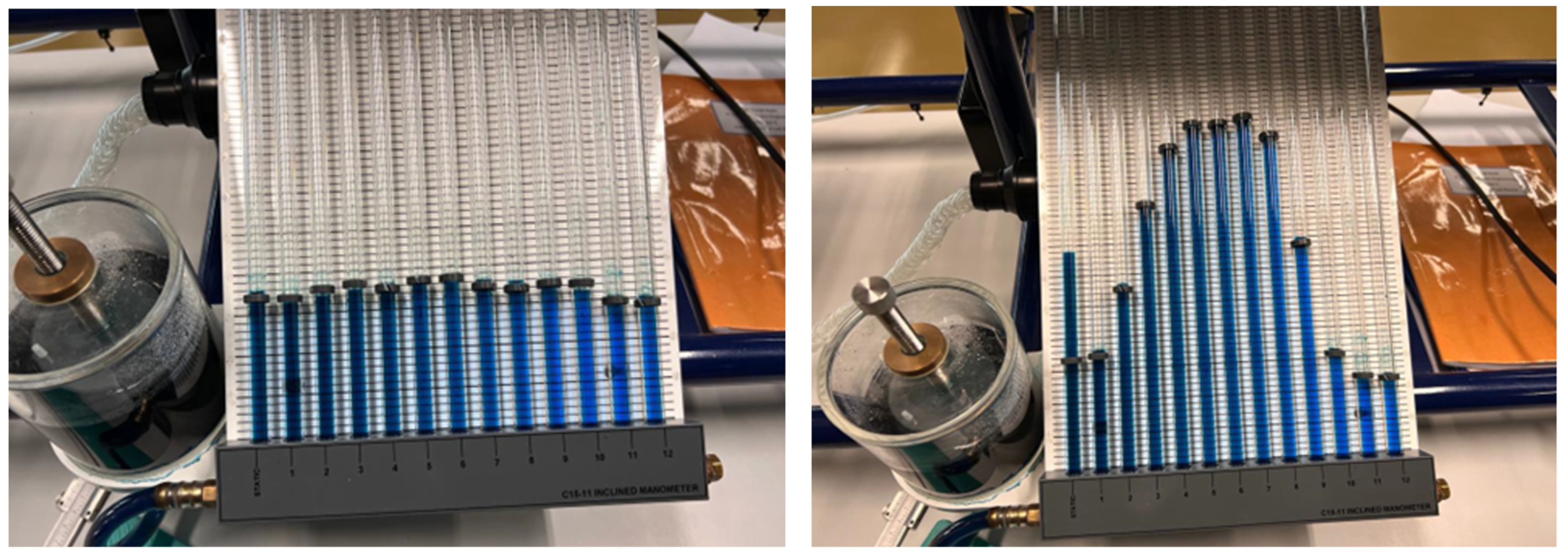
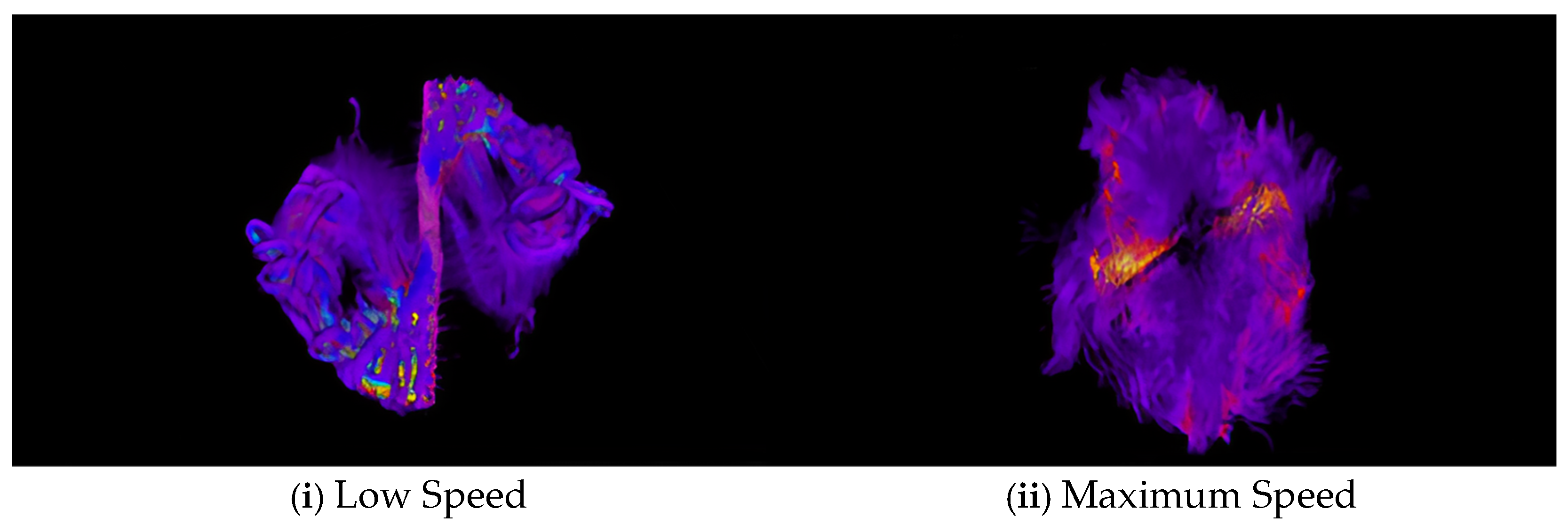
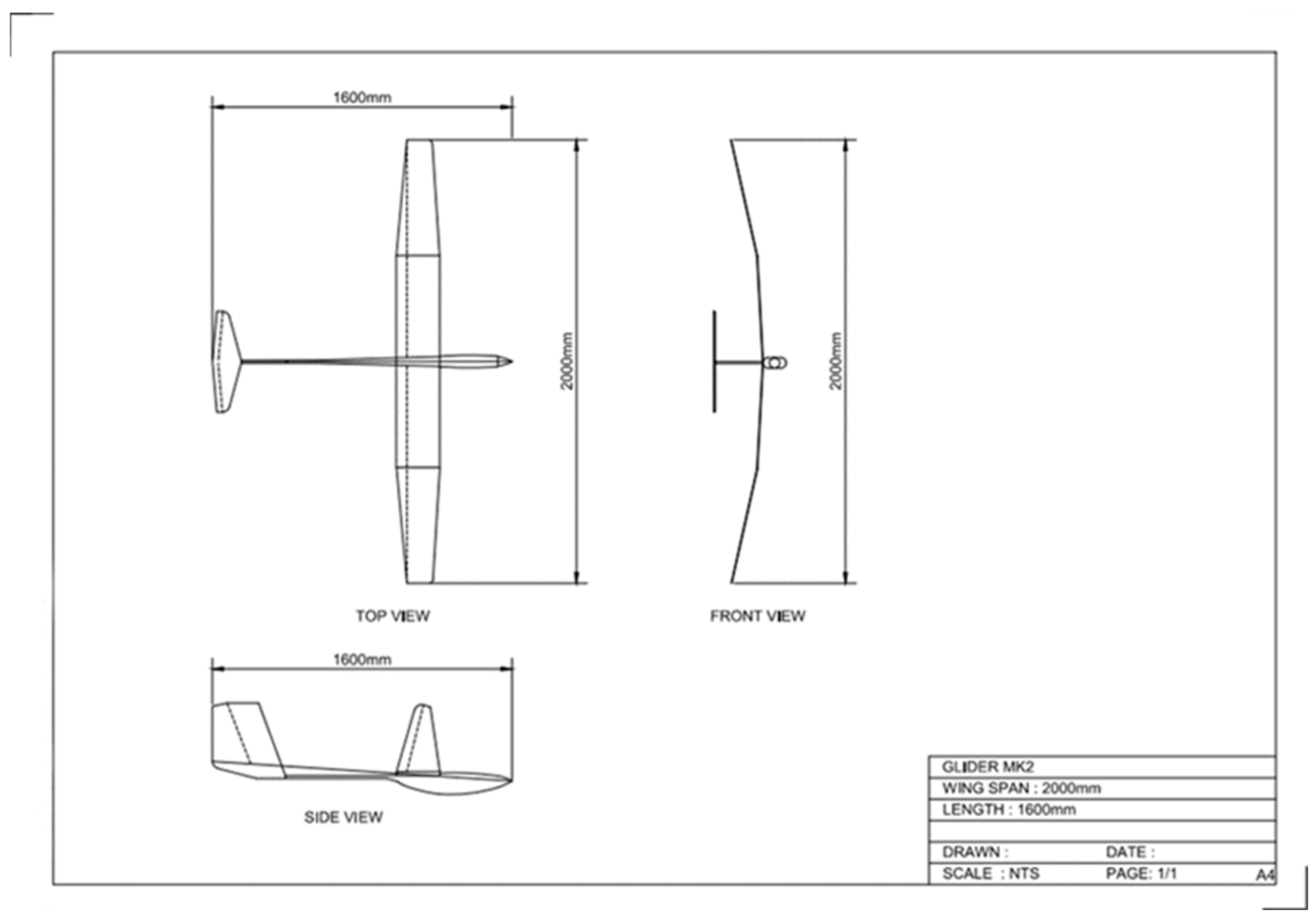
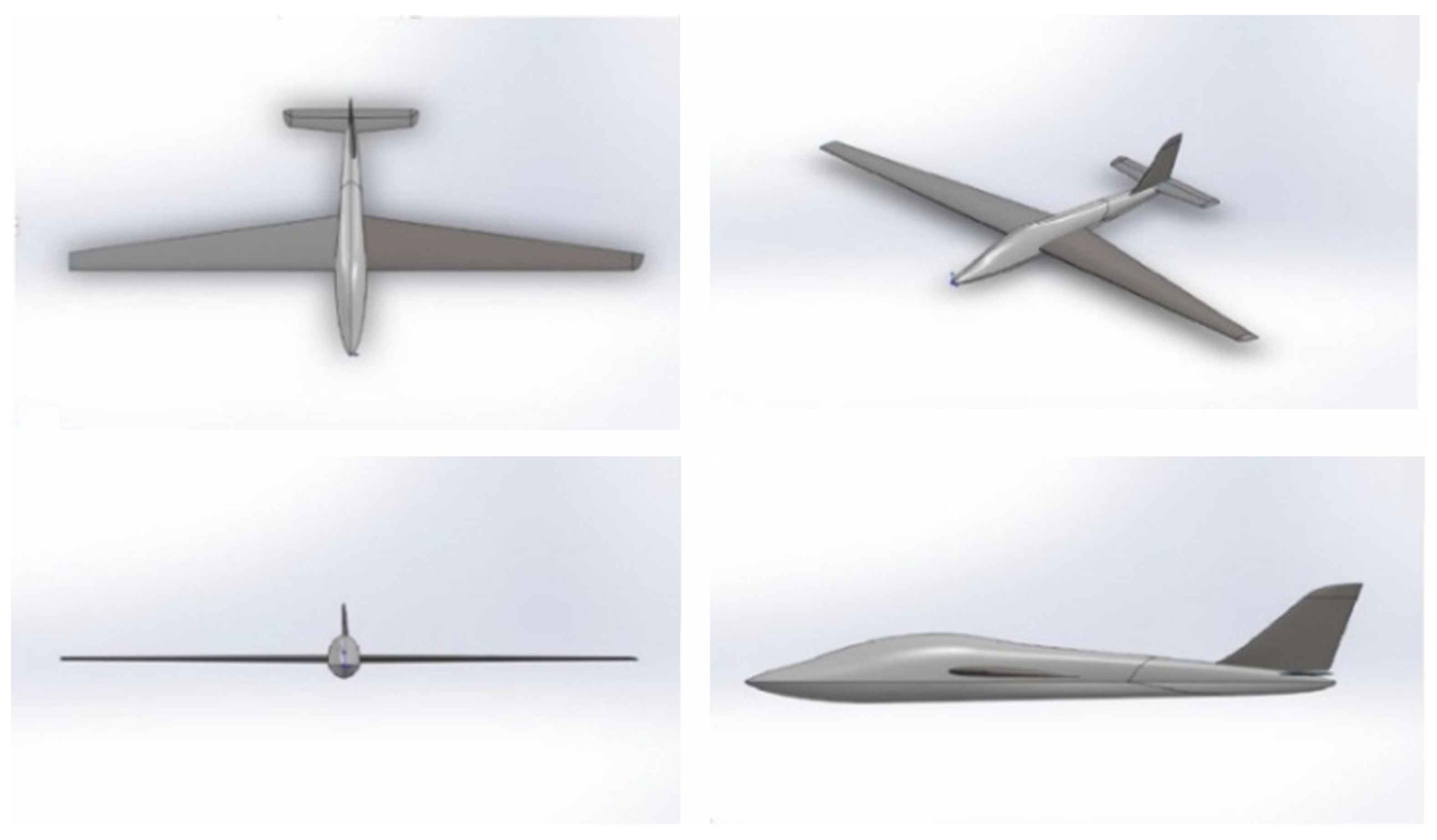


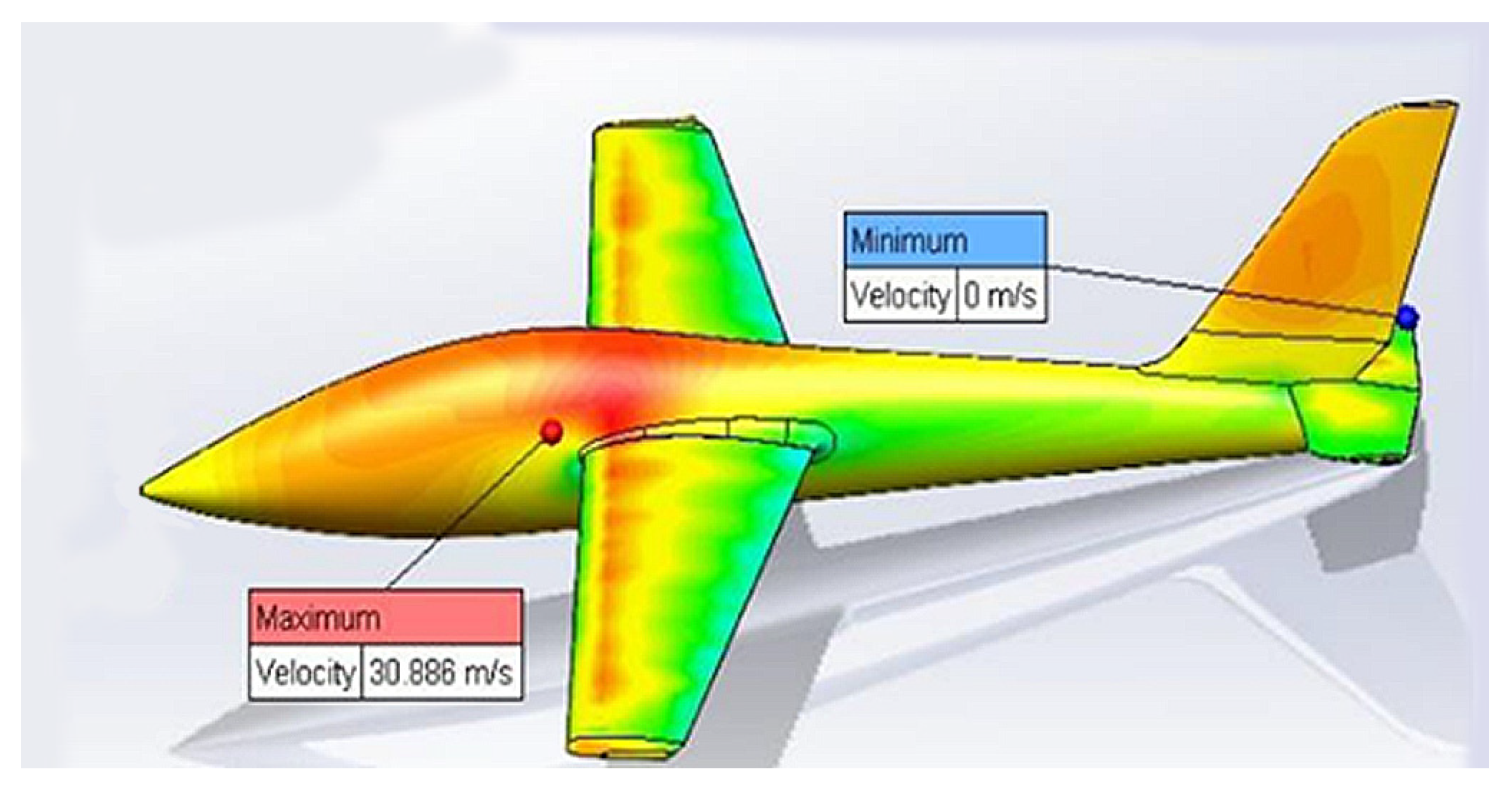
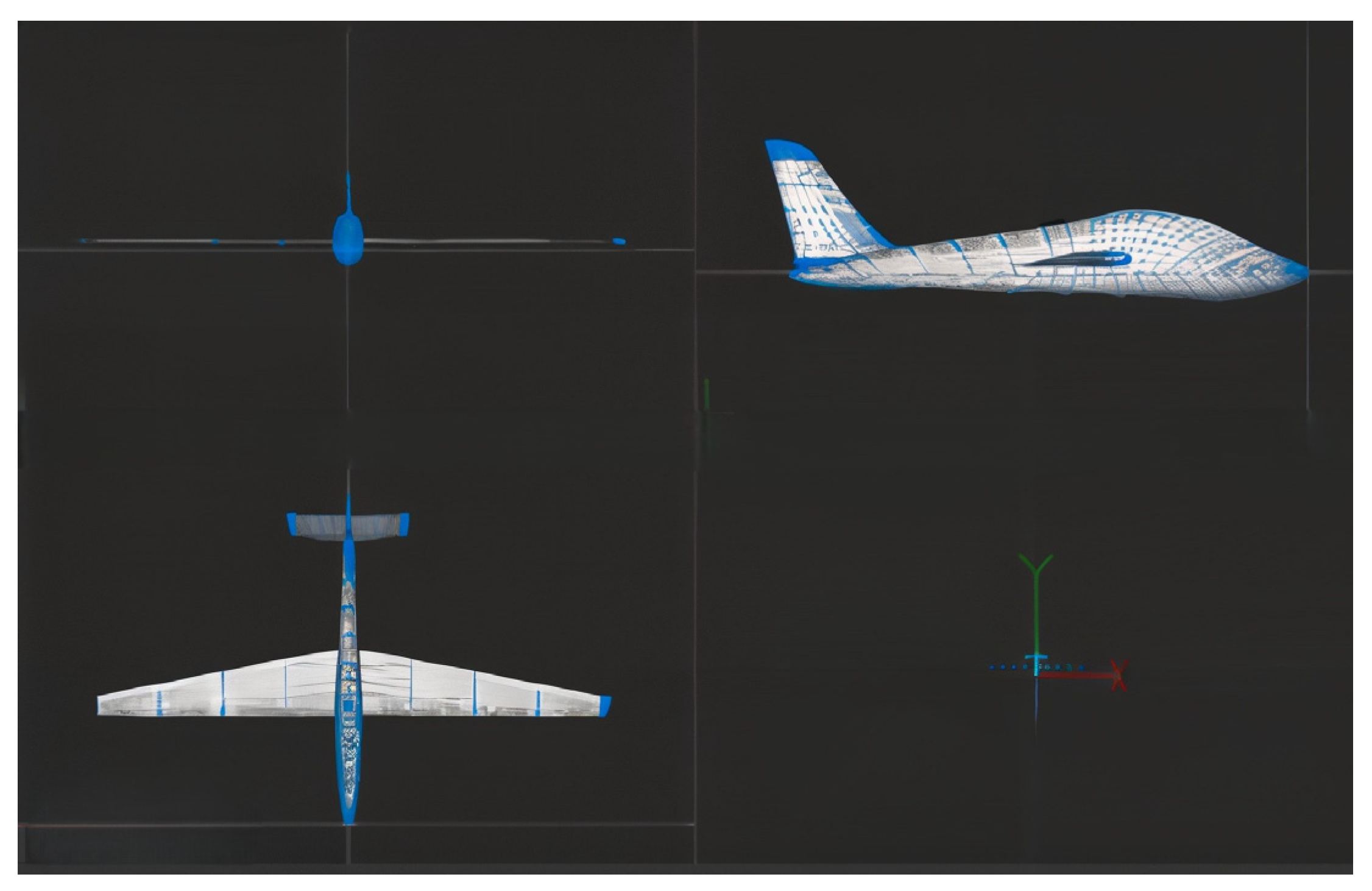
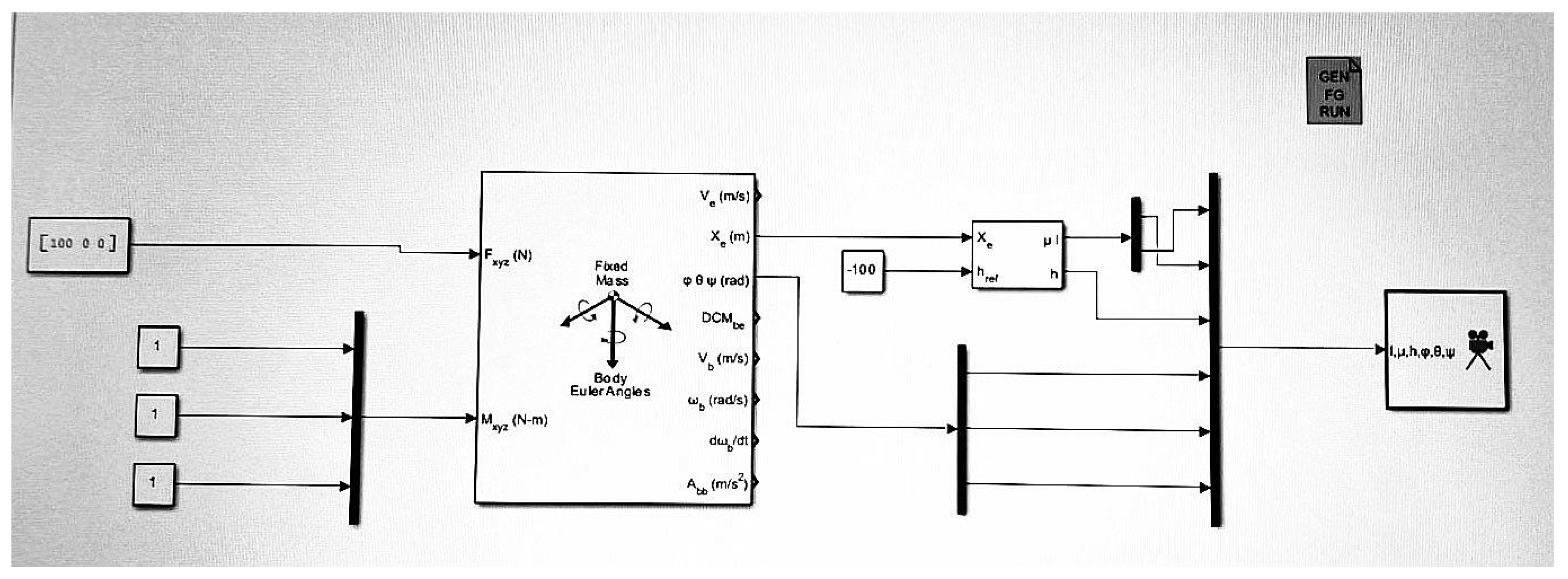

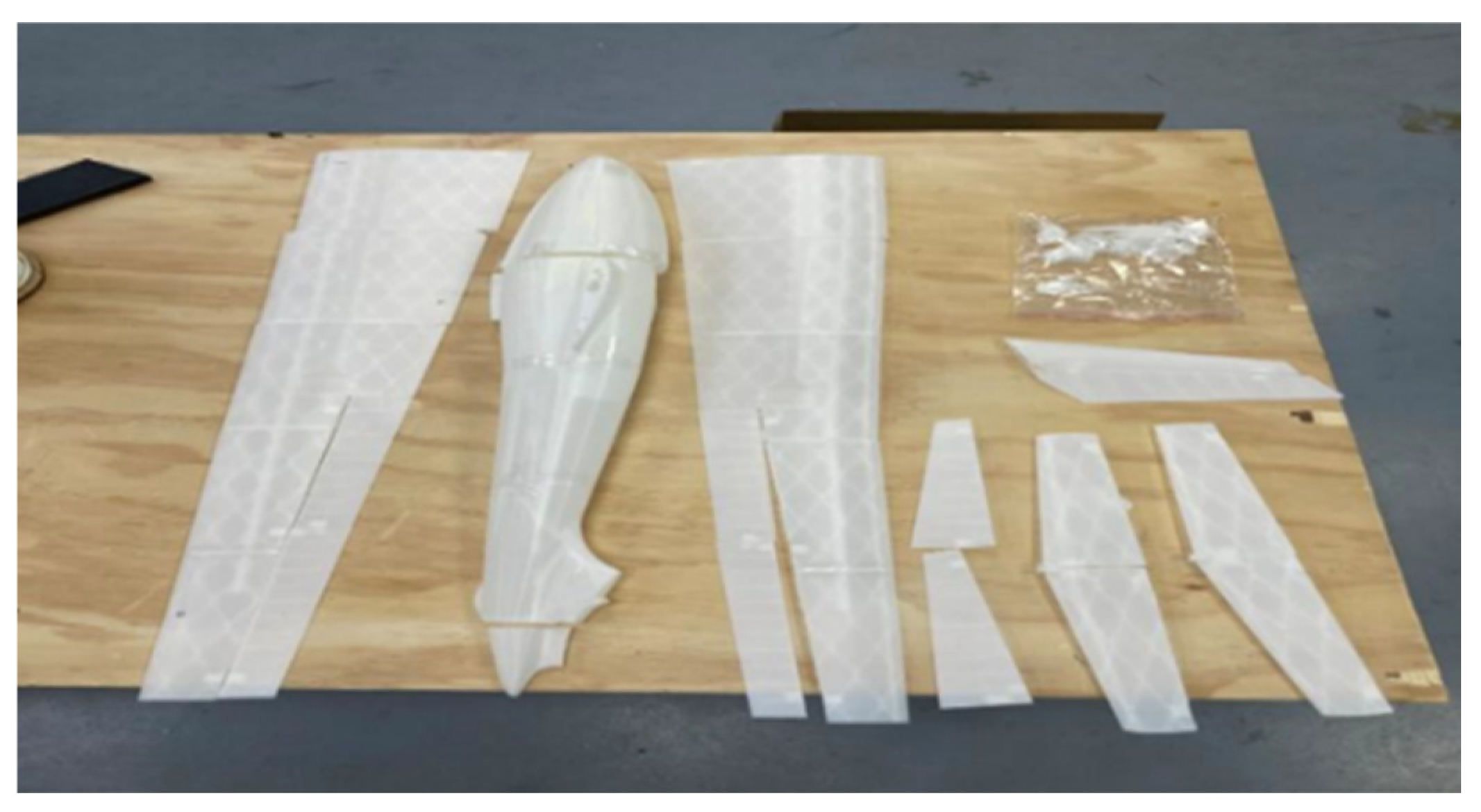
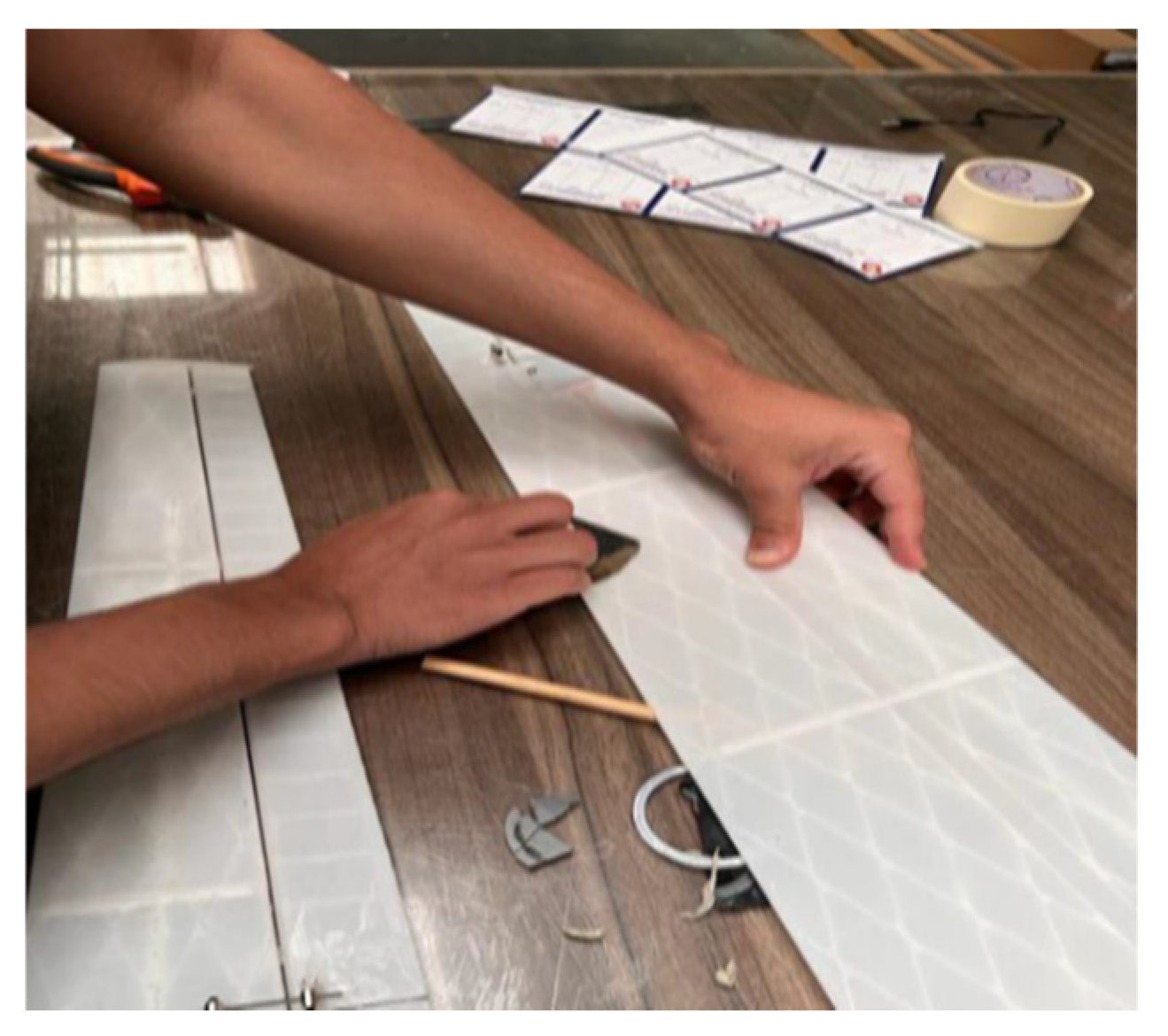

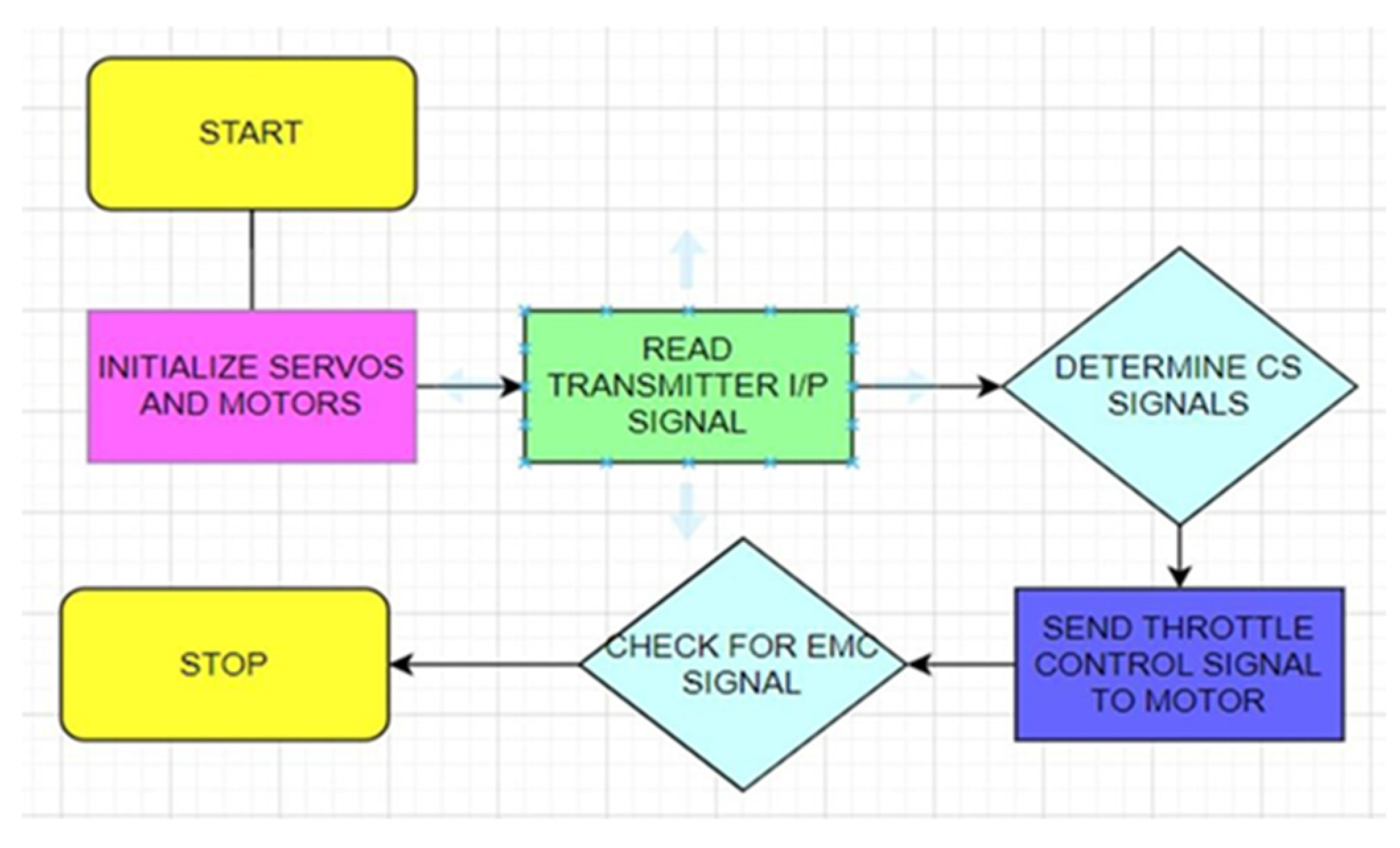

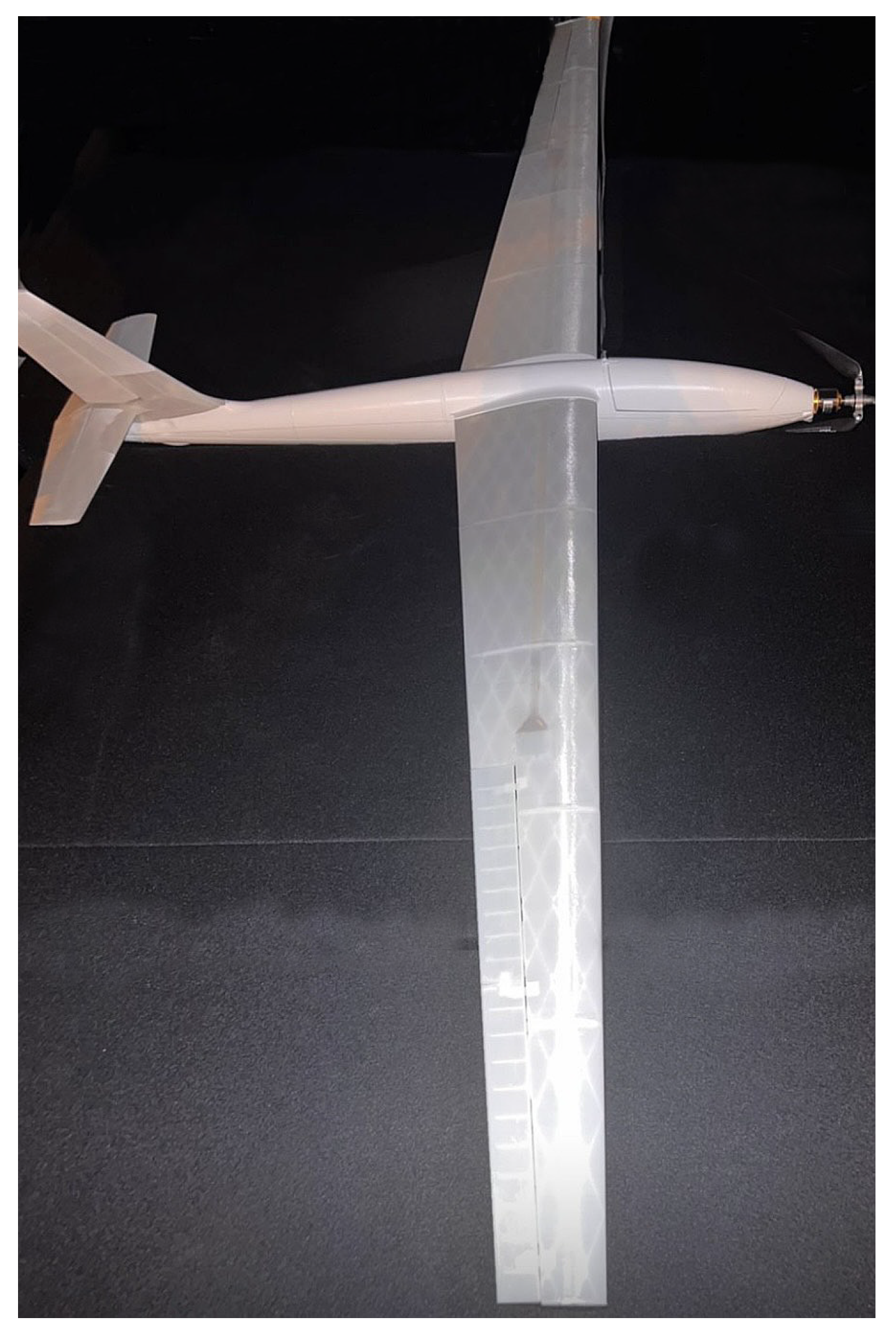
| Mesh Numbers | CL | CD | CL/CD |
|---|---|---|---|
| 30,000 | 0.548 | 0.029 | 18.51 |
| 35,000 | 0.589 | 0.028 | 20.49 |
| 40,000 | 0.597 | 0.025 | 23.32 |
| 45,000 | 0.603 | 0.024 | 25.89 |
| 50,000 | 0.613 | 0.023 | 25.89 |
| 55,000 | 0.625 | 0.021 | 29.74 |
| 60,000 | 0.631 | 0.019 | 32.17 |
| 65,000 | 0.655 | 0.015 | 41.80 |
| 70,000 | 0.659 | 0.014 | 45.09 |
| 75,000 | 0.665 | 0.014 | 45.51 |
| CL | CD | Lift (N) | Drag (N) |
|---|---|---|---|
| 0.516 | 0.026 | 1256 | 526 |
| 0.546 | 0.026 | 1259 | 549 |
| 0.549 | 0.026 | 1526 | 526 |
| 0.546 | 0.028 | 1265 | 598 |
| 0.591 | 0.026 | 1289 | 540 |
| 0.519 | 0.025 | 1247 | 562 |
| 0.569 | 0.024 | 1263 | 597 |
| Parameter | CFD (ANSYS) | Wind Tunnel | % Deviation |
|---|---|---|---|
| Lift Coefficient (CL) | 0.52–0.60 | 0.52–0.61 | ~3–5% |
| Drag Coefficient (CD) | 0.025–0.030 | 0.025–0.030 | <5% |
| Lift Force (N) | 1250–1310 | 1247–1313 | ~5% |
| Drag Force (N) | 500–540 | 502–549 | ~5–10% |
| Properties | Values |
|---|---|
| Density | 1.24 g/ |
| Tensile Strength | 60 MPa |
| Flexural Strength | 108 MPa |
| Elongation | 9% |
| Young’s Modulus | 3100 MPa |
| Shore Hardness, D | 85 Sh D |
| Melting Temperature | 145–160°C |
| Glass Transition Temperature | 566–64°C |
Disclaimer/Publisher’s Note: The statements, opinions and data contained in all publications are solely those of the individual author(s) and contributor(s) and not of MDPI and/or the editor(s). MDPI and/or the editor(s) disclaim responsibility for any injury to people or property resulting from any ideas, methods, instructions or products referred to in the content. |
© 2025 by the authors. Licensee MDPI, Basel, Switzerland. This article is an open access article distributed under the terms and conditions of the Creative Commons Attribution (CC BY) license (https://creativecommons.org/licenses/by/4.0/).
Share and Cite
Eldo, J.; Sibi, S.; Ibrahim, Z.A.; Ntantis, E.L. Development of an Unmanned Glider for Temperature and Image Monitoring. Drones 2025, 9, 481. https://doi.org/10.3390/drones9070481
Eldo J, Sibi S, Ibrahim ZA, Ntantis EL. Development of an Unmanned Glider for Temperature and Image Monitoring. Drones. 2025; 9(7):481. https://doi.org/10.3390/drones9070481
Chicago/Turabian StyleEldo, Joel, Sivasankar Sibi, Zehin A. Ibrahim, and Efstratios L. Ntantis. 2025. "Development of an Unmanned Glider for Temperature and Image Monitoring" Drones 9, no. 7: 481. https://doi.org/10.3390/drones9070481
APA StyleEldo, J., Sibi, S., Ibrahim, Z. A., & Ntantis, E. L. (2025). Development of an Unmanned Glider for Temperature and Image Monitoring. Drones, 9(7), 481. https://doi.org/10.3390/drones9070481






